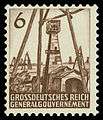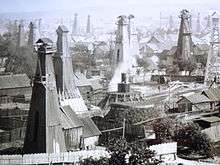Boryslav
| Boryslav Борислав | |
|---|---|
| City of regional significance | |
|
Church of St. Anne | |
 Boryslav Location of Boryslav | |
| Coordinates: 49°17′21″N 23°25′08″E / 49.28917°N 23.41889°ECoordinates: 49°17′21″N 23°25′08″E / 49.28917°N 23.41889°E | |
| Country | Ukraine |
| Oblast | Lviv Oblast |
| Municipality | Boryslav |
| First mentioned | 1387 |
| Government | |
| • Mayor | Volodymyr Firman |
| Area | |
| • Total | 37.0 km2 (14.3 sq mi) |
| Population (2016) | |
| • Total | 34 392 |
| Website | www.boryslavmvk.gov.ua |
Boryslav (Ukrainian: Борислав, Polish: Borysław) is a city located on the Tysmenytsia River (a tributary of the Dniester), in Lviv Oblast (region) of western Ukraine. Boryslav is designated as a city of oblast significance. It is a major center of petroleum industry. Population: 34,392 (2016 est.)[1].
History
The area of the modern town of Boryslav has been inhabited at least since the Bronze Age. There are remnants of a pagan shrine from the 1st millennium BC located in the area, where approximately 270 petroglyphs are found, mostly depicting solar signs - symbols of a pre-Christian Solar deity. Between the 9th and 13th centuries, the site of the modern town housed a fortress named Tustan, which was part of a belt of similar strongholds defending the Kievan Rus' from the west and south. After the dissolution of Kievan Rus', the town became a part of the Halych-Volhynian Principality. With the collapse of the latter, in the 14th century Boryslav became a part of the Crown of the Kingdom of Poland. It was first mentioned in a document from 19 March 1387, listing all personal belongings of Queen regnant Jadwiga of Poland.[2]
Since that time, Borysław, as it was then called, was a small town related to the nearby metropolis of Lwów (currently Lviv, Ukraine) and mostly shared its fate. In 1772, during the Partitions of Poland, it was annexed by Austria and became a part of the Austrian Kingdom of Galicia and Lodomeria. One of the great technological developments of the 19th century was the discovery by pharmacist Johan (Jan) Zeh (1817–1897, in nearby Lviv) of technology that led to the establishment of a new industry based on petroleum. Scientists worked out a method of distilling Boryslaw crude oil, and on 30 March 1853 made the first kerosene lamp. As early as 31 July 1853 their new lamp was used to illuminate the Public Hospital in Lvov. Their discoveries marked the beginnings of the rapid search for petroleum in the Carpathians—especially in the eastern sector of the mountain chain where rich oil deposits were discovered. In 1854 the first ozokerite mine was started in the town after the ore was discovered by Robert Doms. In the second half of 1853, following the research of Jan Zeh,[3] and several other scientists working in the nearby city of Lemberg, the town and its surroundings saw the emergence of an oil industry. One of the first oil rigs in the world was built near Boryslav by Robert Doms in 1861. The oil and mining industries developed quickly. In 1909, more than 1,920,000 tonnes of oil were produced in the region—roughly 5% of the world's oil production at that time. The number of oil rigs also rose from 4,000 in 1870 to over 12,000 three years later. The oil boom drew many industry moguls from all over Austria-Hungary and many fortunes were earned and lost there.[4] A period of prosperity saw the city's population grew as almost 10,000 new workers arrived to the area. In 1886 an oil mining school was opened in Borysław, one of the first such facilities in Europe. Also the ozokerite, a natural mineral wax, mined in Borysław, was used for insulation of the first trans-Atlantic telegraphic cable line. On 31 December 1872, a railway line linking Borysław with the nearby city of Drohobycz (now Drohobych, Ukraine) was opened.
After the Great War and the Polish-Ukrainian War of 1918–1919, the area became part of the newly-reborn Poland. In 1920 the mining school was significantly expanded and was renamed to Carpathian Geological Station, a de facto oil mining university. As the capital of the Zagłębie Borysławskie (Borysław Oil Area), the town of Borysław was the centre of then Polish oil and ozokerite extraction industries and one of the most important industrial zones of Poland. Because of that, on July 26, 1933, the town was granted a city charter. Together with the nearby settlement of Tustanowice (Tustanovychi, now part of Boryslav), Boryslaw produced in 1925 about 80% of Polish oil (812,000 tons). Boryslav was then commonly called the "Polish Baku".
After the 1939 Soviet invasion of Poland the town was annexed by the Soviet Union under the terms of the Molotov-Ribbentrop Pact. It was allocated to the Ukrainian SSR and renamed Boryslav. In 1941 the city fell under German control upon the advances of the German army to the east at the start of Soviet-German hostilities. On the day following the Germans’ arrival, local Ukrainians and Poles, led by German soldiers, murdered approximately 300 Jews. The first anti-Jewish actions began at the end of November 1941, when around 1500 Jews, the majority of whom were deemed weak and unable to work, were shot by the German security police in the forest near the town of Truskavets. During the winter of 1941-1942, many Jews died of hunger and disease. From the end of July till the beginning of November 1942, about 8.500 Jews from Boryslav and neighboring villages, like Pidbuzh and Skhidnytsya, were sent to the Janowska concentration camp or Belzec. Meanwhile, two separate ghettos were created in Boryslav. During the second aktion in February, 1943, 600 Jews were shot by members of the Ukrainian Auxiliary Police, German police, and the Schupo. The isolated executions of Jews took place all the time from May till June 1943 until the total liquidation of the Boryslav ghetto at the end of June 1943. Over the course of one week, the German forces murdered around 700 Jews (sick, young and elderly Jews). The remaining Jews were deported to different labor camps (Plaszów and Mauthausen) from April to June 1944. In all, over 10,000 Jews native to Boryslaw were shot by Germans or murdered in the camps.[5]
A personal-account history of this period is recounted by the Polish-American writer—and Boryslav native—Wilhelm Dichter in his popular and acclaimed literary debut, Koń Pana Boga. It is a memoir of the war in Borsylav as Dichter experienced it as a Polish-Jewish child.
Following Germany's defeat in World War II, the town came again under the Soviet rule. Since 1991 the town has been part of an independent Ukraine. Although the oil and gas deposits have almost depleted, the oil industry remains the main branch of local industry.
Landmarks and visitor attractions
- Tustan fortress, a historic-cultural preserve
- Skole Beskids, a National Park
People from Boryslav

- Hank (Henek) Brodt (born 1925), Holocaust survivor and author
- Johan (Jan) Zeh (1817–1897), pharmacist, discovery of technology that led to the establishment of a new industry based on petroleum. Scientists worked out a method of distilling Boryslaw crude oil, and on 30 March 1853 constructed the first kerosine lamp.
- Mykhailo Dragan (1899), Ukrainian art historian, born in Tustanovychi.
- Zbigniew Balik (born 1935), Polish scientist and politician, deputy to the Sejm 1989–1991.
- Wilhelm Dichter (born 1935), engineer, Holocaust survivor and writer.
- Wladyslaw Nehrebecki (1923–1978), a Polish animator and cartoon director, creator of Bolek and Lolek.
- Michael Sobell (1892–1993), British businessman and philanthropist.
- Piotr Wach (born 1944), Polish scientist, academic professor (Politechnika Opolska), politician and Senator.
- Szewach Weiss (born 1935), Israeli politician.
- Vira Vovk (born 1926), Ukrainian poet.
- Zdzislaw Zygulski (born 1921), Polish art historian and professor of the Academy of Fine Arts in Kraków.
Gallery
 Oil pumps in the Boryslav city park, 2009
Oil pumps in the Boryslav city park, 2009 World War II German post stamp
World War II German post stamp Coat of arms in 1996–2012
Coat of arms in 1996–2012- The bell tower of the Church of St. Anna.
 Assumption Church
Assumption Church Polish-built Palace of Culture for Oilers, 2009
Polish-built Palace of Culture for Oilers, 2009- City administration building, 2006
 Visit of Francis Joseph I to Boryslav by Wojciech Grabowski, 1880
Visit of Francis Joseph I to Boryslav by Wojciech Grabowski, 1880 Oil wells in Boryslav
Oil wells in Boryslav
See also
- Wilhelm Dichter
- Sabina Wolanski (1927–2011), Holocaust survivor
References
- ↑ "Чисельність наявного населення України (Actual population of Ukraine)" (PDF) (in Ukrainian). State Statistics Service of Ukraine. Retrieved 19 July 2016.
- ↑ "Борислав. Офіційний сайт міської ради. — Історична довідка". Boryslavmvk.gov.ua. Retrieved 2013-07-22.
- ↑ Zeh Jan (Зег Ян)
- ↑ Frank, Alison Fleig (2005). Oil Empire: Visions of Prosperity in Austrian Galicia. Harvard Historical Studies. Harvard University Press. ISBN 0-674-01887-7.
- ↑ http://yahadmap.org/#village/boryslav-boryslaw-lviv-ukraine.624
External links
| Wikimedia Commons has media related to Boryslav. |
- Boryslav in the Encyclopedia of Ukraine
- Soviet military topographic map 1:100,000
- holocaust memories [memories of a lost childhood by holocaust from Prof. Lipman]
- [Hank Brodt Holocaust Memoirs - A Candle and a Promise by Deborah Donnelly]
.jpg)